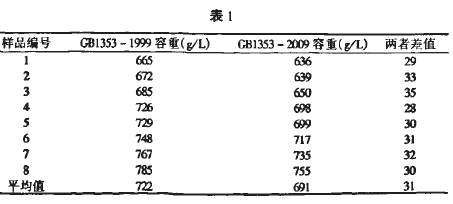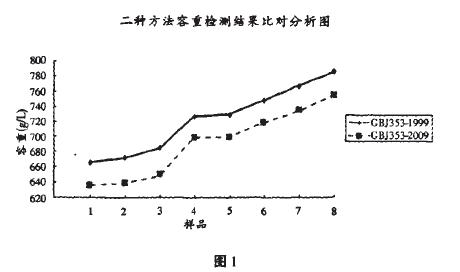Comparison and Analysis of Maize Bulk Density Detection Methods
In 2009, China revised the measurement standard for corn bulk density and issued GBl353-2009 instead of GBl353-1999. The new standard is based on the 1999 version of the standard framework, which mainly adjusts the number of grades; modified the measurement method of bulk density; increased the method of testing the bulk density of corn using a trial corn bulk density of more than 18%; adjusted the imperfect grain index; Added inspection rules and labeling requirements. The new standard is still based on weight and other indicators, imperfect grains, impurities, moisture, color, odor as a limiting factor. In order to better implement the new standard. Understand the technical differences between the new standard and the Old standard in the detection of bulk density, and accurately grasp the technical essentials and operating procedures of the new standard. The author has specifically conducted comparative tests and analysis of the new and old standard test methods for bulk density.
l The significance of the revision of the new standard The revised standard actively uses international standards and foreign advanced standards. The setting, evaluation and methods of the main indicators are in compliance with WrID regulations. The new standard sets out from the reality of grain production in China, taking into account the interests of the country, producers, and consumers, promoting and improving the quality of grain varieties, realizing higher prices for better quality, raising farmers' awareness of quality, and enhancing China's major grain varieties in the international market. The competitiveness of the market is of great significance. 
2 Main differences between GBl351-1999 and GBl35l-2009 bulk density testing methods
2.1 The use of different methods of measuring bulk density The new and old standards also use the GHCs-1000 type grain container (40mm under the funnel), but the method of use is different, that is, in the method for determining the bulk density of corn in Appendix A of the 1999 edition. The gas cartridge was placed in the capacity cylinder in advance, and the measured corn was directly dropped from the cereal cylinder through the middle cylinder to the capacity cartridge (see Appendix A of GBl35l-1999). In the 2009 edition of Appendix A, the exhaust gas volume was measured on the top of the insert when the volumetric weight was measured, and the exhaust gas and the sample fell down to the capacity level (see Appendix C of CBl351-2009).
2.2 Differences in determination methods for bulk density of corn with moisture greater than 18% CBl351-1999 (7.2) states: “When the sample temperature is above 0°C, the moisture content is between 18.0% and 23.0%. The actual bulk density of corn plus the added bulk density is based on the 18.0% (inclusive) moisture content and the moisture content is increased by 1 percentage point. The bulk density is increased by 59/L.†And GBl35l-2009 canceled the original standard high. In addition to the provisions for the addition of moisture to the bulk density of corn, the Appendix B “Technical Conditions and Operational Methods for Rapid Drying and Rainfall-Making Equipment for Maize†has been added. For corn with moisture greater than 18%, the moisture content of the corn has been reduced by rapid laboratory drying and precipitation equipment and a rapid moisture analyzer. To 18% or less, wait until the corn sample is cooled to room temperature and then measure the bulk density according to Appendix A (see GB 1351-2009 Appendix B).
3 CBl351-1999 and GBl351-2009 comparison tests of bulk density testing methods

This experiment is to adopt the new and old standards to test the bulk density of corn grain samples, aiming at further analysis and verification of the difference of the two methods of bulk density determination.
3.1 Materials and Methods
(1)Materials Eight corn samples were used as test materials in this experiment. Sample moisture was below 18%. Impurities, imperfect grains, and moldy grains were all within the control range of the national standard, ie, impurity ≤ 1. O%; imperfect grain ≤ 4.0 to 15. O%; mold grain ≤ 2. O%.
(2) Apparatus and utensils CHC-1000 type grain container; grain powder screening sieve: upper sieve diameter 12. Onm, the lower sieve diameter 3.0IIèš°, with a sieve bottom and sieve cover.
(3) Methods The original standards cBl35l-1999 appendix A and the new standard GBl35l-2009 appendix A were used for the determination.
(4) Data analysis and analysis of test results According to the results of the 8 test pieces of maize selected by corn bulk density device, the measured results of bulk density were numbered sequentially from low to high, and the test data were collected (see Table 1). In order to make the difference between the new and old method detection results more intuitive, we draw a comparative analysis chart based on the statistical data in Table 1 (see Figure 1). The experimental results show that there are significant differences in the results of determining the bulk density of the eight maize samples by using two methods. From the table, it can be seen that the measured value of the new method is significantly lower than the original method, with an average of about 31∥L. As can also be seen from the figure, the results of the two methods show a good linear relationship, but sometimes the line spacing (ie, the difference) is variable, and there is no regular state, the analysis of the reasons in addition to different methods of determination, but also by the sample Its own characteristics such as: particle size, fullness, smoothness, good impurities, moisture and other factors.
4 Discussion The important difference between the new and old standards of bulk density testing method is to change the position of the exhaust port from the plug to the plugboard. In the original method, the exhaust port was always placed at the bottom of the capacity cylinder. The exhaust port was only a non-functioning object in the load port. The new method was to place the exhaust port on the board, and the sample was in the row. The upper part of the air helium falls into the capacity cylinder together with the exhaust port. At this time, the role of the exhaust enthalpy is to damp and buffer the falling material, so that the air resistance of the material is consistent and the flow rate is balanced, thereby reducing the measurement error. The exhaust port plays a crucial role in ensuring the stability and accuracy of the measurement results. The original standard is that the sample falls directly into the capacity cylinder from the cylinder through the intermediate cylinder. Because of the long drop path, the gap is large. Under the effect of gravity, the sample is continuously pressed and compacted, and the density per unit volume increases, resulting in bulk density. Virtual height. The new standard adds the middle board procedure, so that the sample first falls from the grain barrel into the middle barrel with the exhaust port and the plugboard, and then the middle barrel falls into the capacity cylinder together with the exhaust port, because the drop is reduced. (reduction of 30cm) greatly reduces the influence of gravity and sample properties on the test results of bulk density and improves the accuracy of the test.
The new standard eliminated the addition of high-moisture corn bulk density, but added Appendix B, which regulates the rapid precipitation operation specification. The experimental results show that, after high-moisture maize precipitation (natural drying and drying tower drying), the bulk density increase or decrease showed no regular changes, the original standard in the water content of more than 18% of the bulk of the corn supplement, and the actual test results Certain differences, especially those with more than 23% moisture, are even more pronounced, so the new standard adds Appendix B. The high-moisture corn was first reduced to below 18%, and then the weight-response result was more close to the true value.
Experimental results We found that the original standard corn bulkhead double test error is relatively large, and the use of the revised new standard measurement results double test error is relatively small. The reproducibility of measurement is better, which shows that the new standard is more scientific, accurate, and operable than the old standard.
More Instruments: Amylose Analyzers Experimental Rice Mills
Hot Forging,Hot Forging Press,Carbon Steel Forging
Krong International Trade Limited , http://www.shdiecasting.com